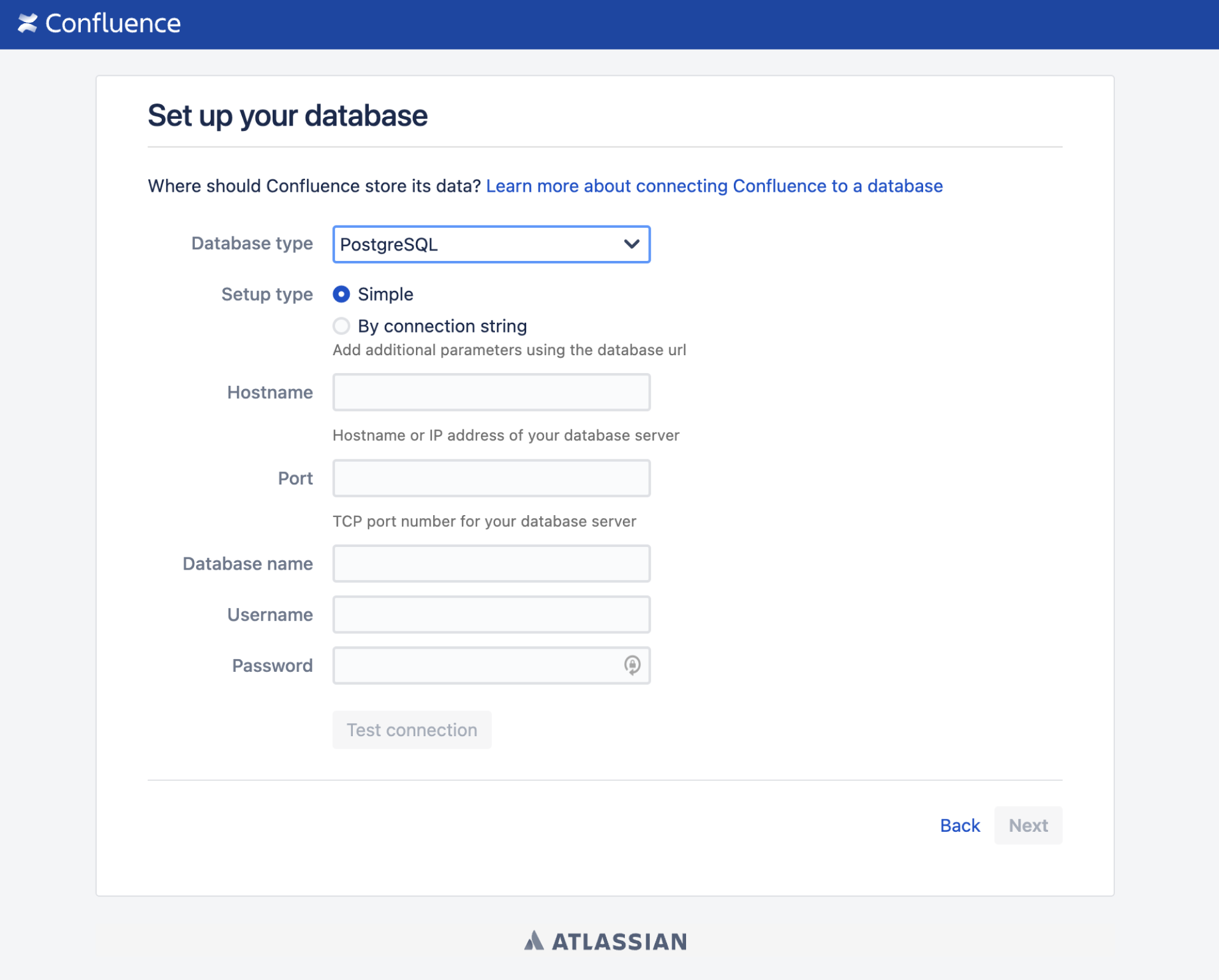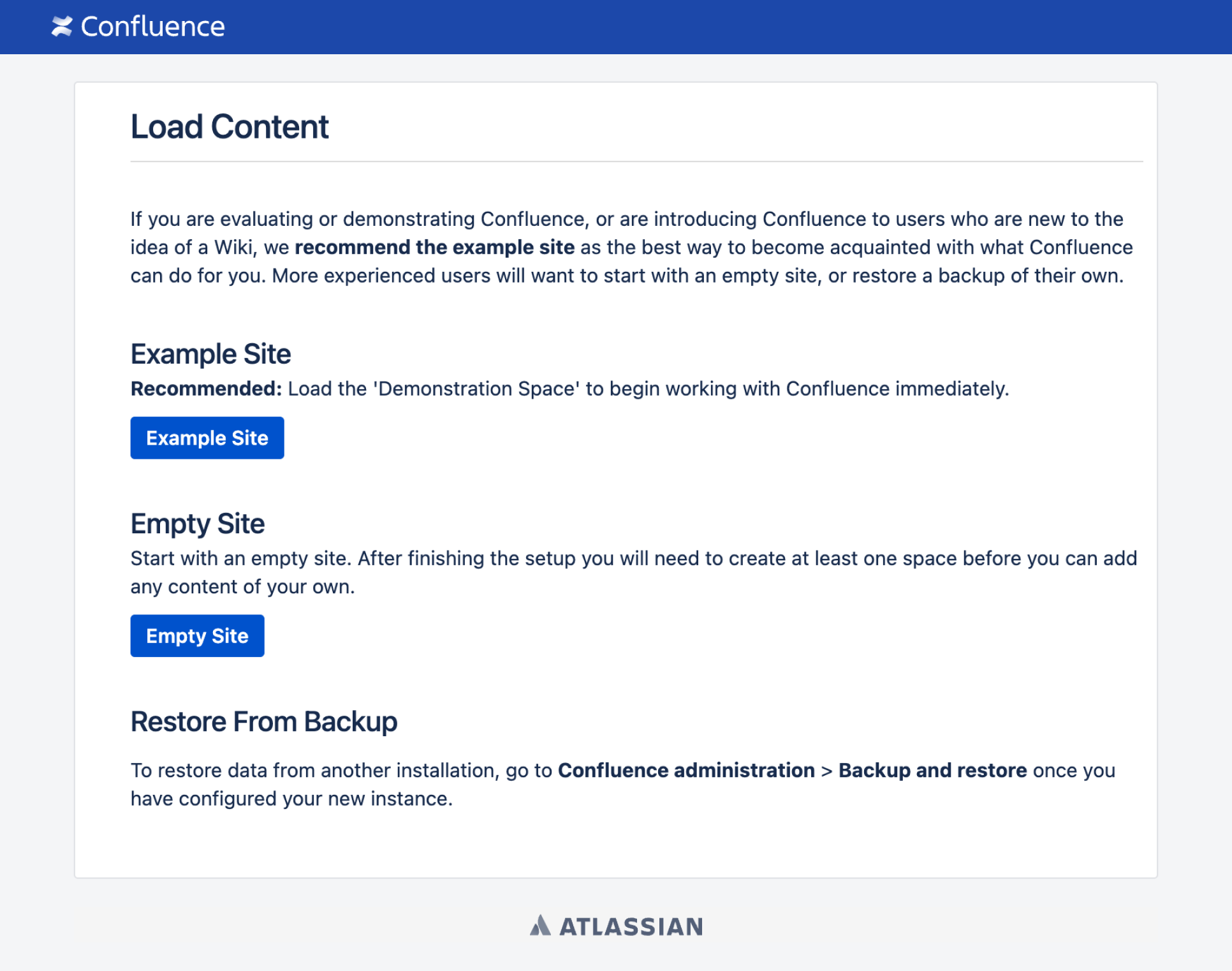Confluence Setup Guide
Before running the Confluence Setup Wizard, as described below, you should have already completed installing Confluence.
When you access Confluence in your web browser for the first time, you will see the Confluence Setup Wizard. This is a series of screens which will prompt you to supply some default values for your Confluence site. It will also offer some more advanced options for setting up data connections and restoring data from a previous installation.
1. Start the setup wizard
- Start Confluence (if it is not already running)
For Windows, go to Start > Programs > Confluence > Start Confluence.
Or, run the start-up script found in thebinfolder of your installation directory:start-confluence.batfor Windows.start-confluence.shfor Linux-based systems.
- Go http://localhost:8090/ in your browser
If you chose a different port during installation, change '8090' to the port you specified
If you see an error, check you are using the port you specified during installation.
On this page:
2. Choose your installation type
In this step, you'll choose whether you want a trial or a production installation.
- Trial installation
Choose this option if you don't have a license, and want to try Confluence for the first time. You'll need an external database.
- Production installation
Set up Confluence with your own external database. This option is recommended for setting up Confluence in a production environment.
3. Enter your license key
Follow the prompts to generate an evaluation license, or enter an existing license key. To retrieve an existing license key head to my.atlassian.com, or to purchase a new commercial license go to www.atlassian.com/buy.
If you selected a Trial installation in the previous step, Confluence will generate your license. This will take a few minutes. Once complete, go to step 8 below.
If you selected a Production installation, go to the next step to set up your external database.
4. Production installation: database configuration
Before you start
- Character encoding:
- We strongly recommend that character encoding is consistent across your database, application server and web application, and that you use UTF-8 encoding.
- Before setting up your database, please read configuring character encoding.
- Database name: When creating a new external database, give it the name 'confluence'.
Next it's time to set up your database. Some things to consider:
- Check the supported platforms list to confirm that your chosen database and version is supported.
- See database configuration for information on setting up your database, including UTF-8 character encoding requirements.
- If you are using Confluence as a production system you must use an external database.
Screenshot: Database configuration
Database connection
Confluence will connect to your database with a direct JDBC connection. Connection pooling is handled within Confluence.
- Driver Class Name – The Java class name for the appropriate database driver. This will depend on the JDBC driver, and will be found in the documentation for your database. Note that Confluence bundles some database drivers, but you'll need to install the driver yourself if it is not bundled. See Database JDBC Drivers for details.
- Database URL – The JDBC URL for the database you will be connecting to. This will depend on the JDBC driver, and will be found in the documentation for your database.
- User Name and Password – A valid username and password that Confluence can use to access your database.
You will also need to know:
- The size of the connection pool Confluence should maintain. If in doubt, just go with the default provided.
- What kind of database you're connecting to, so you can tell Confluence which dialect it needs to use.
5. Production installation: load content
We can help you get your new Confluence site started with some demonstration content (which you can remove once you're up and running), or you can choose to proceed with an empty site. You'll need to create a space in your new site before you can start adding content.
If you're migrating from another Confluence installation, you will be able to Restore from backup by import your existing Confluence data. This can only be done after the setup wizard is complete by following the instructions on Restore a Site.
Screenshot: Load content screen
6. Set up user management
You can choose to manage Confluence's users and groups inside Confluence or in a Jira application, such as Jira Software or Jira Service Management.
If you want to configure your external user management post-setup, from Administration menu select General Configuration, and then User Directories.
Discover how to configure user directories in Confluence
7. Set up system administrator account
The system administrator has full administrative power over your Confluence instance. This person will be able to add more users, create spaces, and set further Confluence options. Please refer to the overview of global permissions for more information.
If you've delegated user management to a Jira application, we'll use the Jira system administrator account you specified as Confluence's system administrator account.
8. Setup is Complete
That's it, Confluence is ready to go. Click Start to jump straight in to Confluence.
Choose Further Configuration if you want to go directly to the Administration Console and complete administrator's tasks including configuring a mail server, adding users, changing the base URL and more.

